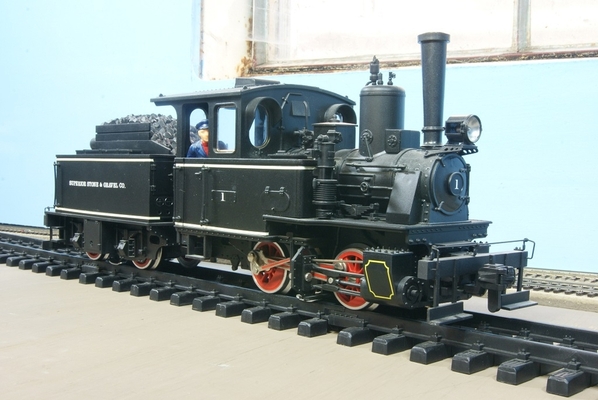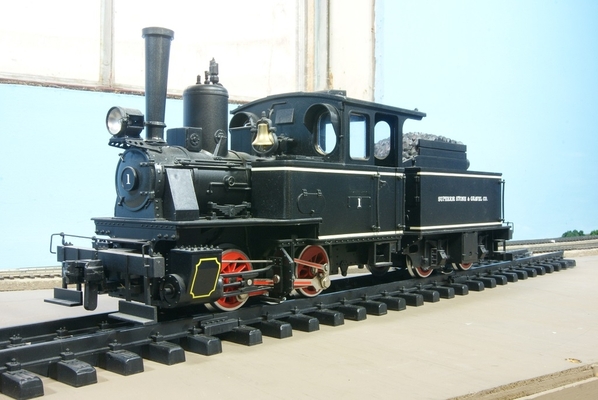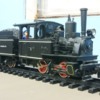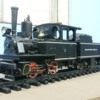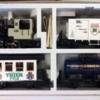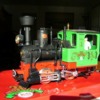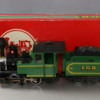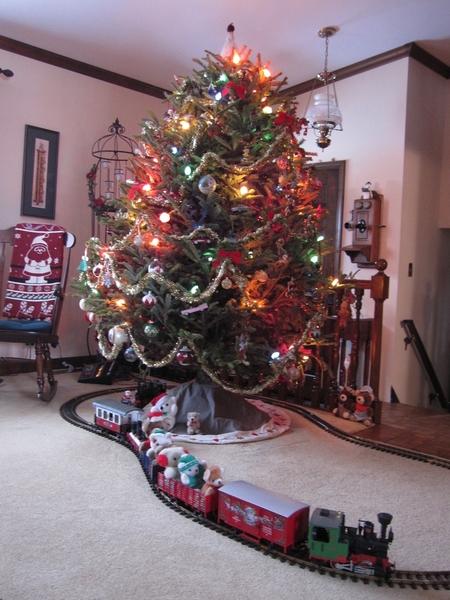When Eberhard and Wolfgang Richter decided to make their Lehmann Grosse Bahn or big train, they chose a diminutive 760mm narrow gauge Austrian prototype called the Stainz. The cab was the largest part of this little 0-4-0 steam locomotive. This loco became the symbol of the LGB line of trains and remains so today. I presently have two models of the Stainz: the black and gray version that powered the limited edition Dortmunder Pilsner beer set (1000 produced). My second engine is the 30th Anniversary (1998) red, green and black edition initially only available to attendees at the factory celebration. The Dortmunder set Stainz has no smoke unit, and the running gear has metal rods. It also has the older split style motor block. The Anniversary Stainz has the drop-in motor block, a smoke unit and plastic running gear. It also has a more detailed cab with a light and gold bezels on the head and backup lights. Both locos have the same standing engineer figure. Both are robust pullers and are among my favorite LGB locos!
"HONGZ" stands for HO scale, N scale, G scale, and Z scale.
Post your non-O scale stuff here!
Replies sorted oldest to newest
I have the Fleishmann On30 version of the Stainz 2:

Rusty
Attachments
I know the Stainz has come to symbolize LGB. But do you think they would have achieved greater market penetration in the US if they had standardized on the all-black and more modern 2076D, or even an American prototype? They certainly sold a lot of Moguls!
@Ted S posted:I know the Stainz has come to symbolize LGB. But do you think they would have achieved greater market penetration in the US if they had standardized on the all-black and more modern 2076D, or even an American prototype? They certainly sold a lot of Moguls!
Seems to me LGB had pretty good market penetration in the US. I picked up my first catalog at La Grange Hobbies (IL) in 1977 or 1978.
Besides, the 2015D wasn't all that hard to "Americanize."
Rusty
Attachments
I prefer the European models and the 1:22.5 scale suits the 760mm and 1000mm protoypes for the gauge one track. The American standard gauge models are better suited to the 1:32 or 1:29 scale on lower profile rail than the regular LGB track.
Rusty: I have a 2015D and with dual motors it is a powerful puller!
PHOTOS of my Dortmunder and the 30th Anniversary Stainz:
Attachments
That is actually my set box as received from my dealer! The folded document in that compartment is a certificate of authenticity for this run of 1000.
I have two more German beer cars: a Tucher Pils (Nuremberg) and a Berliner Kindl (Berlin).
An iconic model! I wonder how far across the earth we could get if all the 2010's and 2020's ever produced were lined up nose to tail.
OMG! It would be a Guiness moment to be sure! LOL!
Rusty: Here is a photo of the Amercanized version of the LGB 2015. It is an LGB 2017:
Attachments
I have the 2017 as well. Bought it in 1985. It ran every Christmas for many years. Still like new in the original box. Very dependable.
The Marshall Field's passenger set from 1984 and the Christmas train my Dad left for me. I remember going to Marshall Field's in Chicago many times in the late 1970s to early 1980s with my dad when he got started with the LGB trains. I think they were the first place in the Chicago area that sold them.
Attachments
NICE! THANKS for sharing! My one and only visit to Marshall Fields in Chicago was in 1981 and they had a nice display of LGB.
LGB was, and still is, considered a premium import and was initially marketed in the US in high-end retail stores like FAO Schwartz and Marshall Fields.
Many of the original LGB starter sets first imported into the US came without a power supply, and the buyer had to purchase an MRC power pack to run their train. Later MRC power packs had a pulse feature which was anathema to LGB Buehler motors! Fortunately, most of the MRC packs had a switchable pulse function, and they were safe to use with the LGB motors.
LGB was always a quality product made of high-grade polymers like BASF Luran-S and Vestilene. Paints used were Mercedes Benz quality. Propulsion was by high quality Buehler 7-pole DC motors in sealed gearboxes. Back in the 1980's, I did service work on LGB locos which ran on commercial layouts in restaurants and a museum, and can testify to their ability to operate reliably under punishing conditions.
The early variations of the Stainz locos like the 2015D and the 2017D were interesting because they were the first engines to include a motorized tender, thus considerably increasing the pulling power of these locos. There is a two wire polarity-observed connection between the engine and tender to insure good electrical conductivity. I am currently enjoying my 2015D!
Attachments
The respective sockets for the connecting cable between the engine and tender are marked with a + and - so as to allay any possible short.





